The Biostar A10N-8800E Motherboard Review: Carrizo in 2019?!
by Dr. Ian Cutress & Gavin Bonshor on August 14, 2019 8:00 AM EST- Posted in
- Motherboards
- CPUs
- AMD
- Biostar
- Mini ITX
- HTPC
- Carrizo
- A10N-8800E
- FX-8800P
- Athlon 200GE
Visual Inspection
The Biostar A10N-8800E motherboard uses a simplistic, yet striking color theme throughout with yellow DDR4 memory slots, a yellow full-length PCIe 3.0 x16 slot, on a black PCB with black connectors. This full-length PCIe 3.0 x16 slot allows users to use a discrete graphics card which is an option if an option with DisplayPort is desired, although the AMD FX-8800P does feature integrated graphics of its own.
In the centre of the PCB is an integrated cooling solution which is made of an aluminium heatsink with a straight-forward fin-array, and a small black fan. This is more than ample for the AMD FX-8800P quad-core processor with its low operating 15 W TDP. There is no overclocking here.
Located at the top of the Biostar A10N-8800E is two memory slots which have support for DDR4-2133 and up to a maximum of 32 GB of capacity. These slots also only support non-ECC memory so users looking to use server grade memory with the intended use of a building a small form factor microserver will have to re-think their options if error correction is a buying factor.
Located above the full-length PCIe 3.0 x16 slot is a single PCIe 3.0 x4 M.2 slot which is also capable of running SATA based drives. This is somewhat unique for a Carrizo desktop system, and well worth the addition. There are also two SATA ports with straight-angled connectors located just below the 24-pin 12 V ATX motherboard power input. With the AMD FX-8800P coming with its own low profile CPU cooling solution, there are two 3-pin fan headers to use for case fans. Nothing fancy and 4-pin PWM fans aren't supported, but the level of cooling required for operation on an integrated SoC option such as this isn't a hefty requirement.
Driving power to the basic three-phase power delivery is a single 4-pin 12 V ATX CPU power input. The power delivery of the A10N-8800E is operating in a 2+1 configuration with each CPU VCore phase consisting of two Sinopower SM4364A N-channel high-side MOSFETs, and a single Sinopower SM4377 N-channel low-side MOSFET. Providing power to the integrated graphics of the AMD FX-8800P is a single dual-driver ISL62773A and is designed for AMD Fusion mobile processors specifically. None of the power delivery includes any form of a heatsink, but due to the low operating power of the FX-8800P, this isn't a requirement.
On the rear panel of the Biostar A10N-8800E is a basic set of inputs, connectors and outputs usually associated with integrated SoC solutions. USB capability is provided by two USB 3.1 G1 Type-A ports and two USB 2.0 ports. A single front panel USB 3.1 header provides an additional two G1 Type-A ports, where the single USB 2.0 header also contributes an extra two ports to the cause. Additionally from left to right, is separate PS/2 keyboard and mouse ports, an HDMI video output capable of delivering the 4K2K high definition resolution, a single D-Sub output, a single 1 GbE LAN port, and three color-coded 3.5 mm audio jacks powered by a Realtek (insert model) audio codec.
What's in the Box
Included in the accessory bundle of the Biostar A10N-8800E are two SATA cables, a silver IO shield, a DVD driver disk and a quick guide to get users up and running. It's a very basic set of accessories, but more than ample as the PCIe 3.0 x4 M.2 slot includes the mounts and screws required for installation on the board already.
- Two straight-angled SATA cables
- IO shield
- Driver installation disc
- Quick installation guide


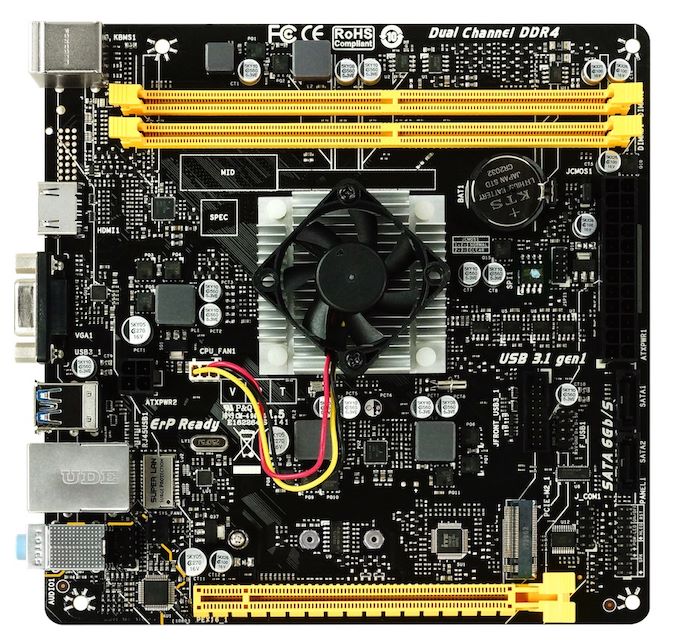
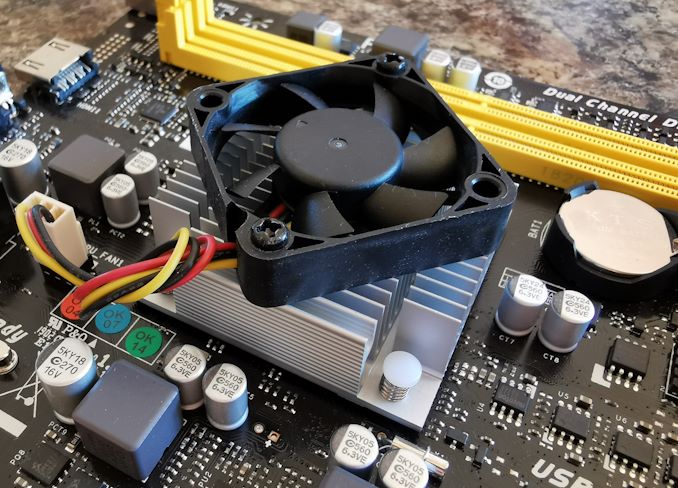
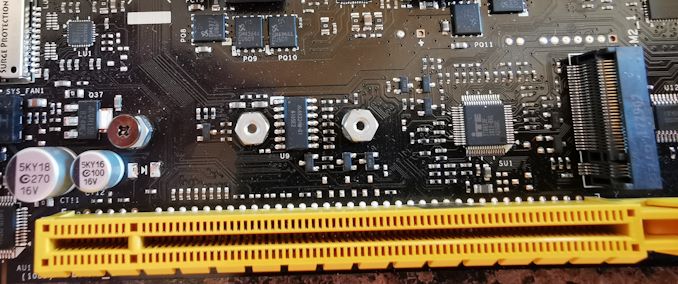
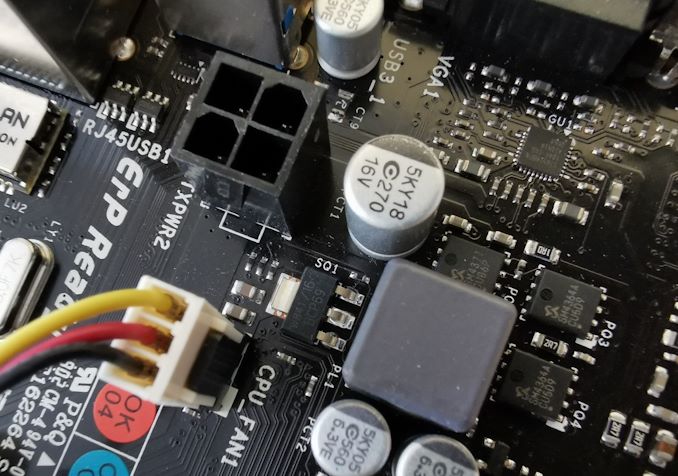

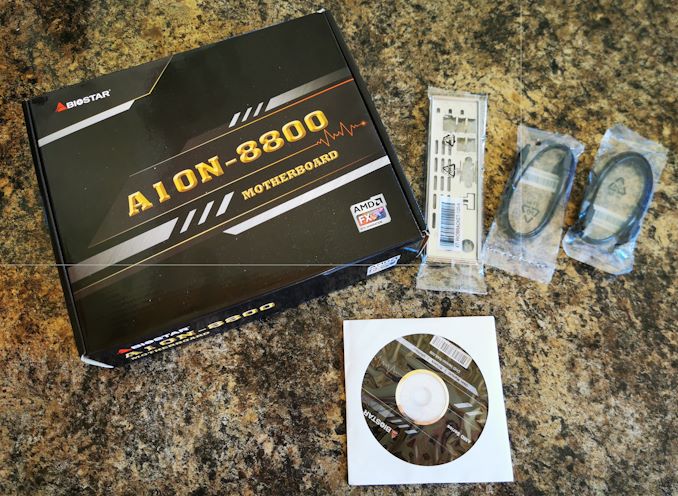








73 Comments
View All Comments
_Rain - Wednesday, August 14, 2019 - link
BothArbie - Wednesday, August 14, 2019 - link
Whatever this board *can* do, not being human it can't "opine". And even humans can't "opine to be".Rocket321 - Wednesday, August 14, 2019 - link
It seems like the obvious thing to do here would be A) put a bunch of SATA on it, or B) put multiple NICs on it. A nice home nas / router / microserver. But as it is, it doesn't quite fit either niche.Haawser - Thursday, August 15, 2019 - link
I bought the A68N-5600 instead. It has an A10-4655M 'Trinity' (4C/6CUs) but also has 4x Sata ports instead of the M.2 slot. Seems to recognise and use DDR3-1600 without a problem. Makes for a very nice mini-PC that costs next to nothing. TBH I'm quite surprised how snappy it is in Windows 10 with a $20 64GB SSD boot drive. I had a dual core Atom mini-ITX before, and this is waaay faster. Like night and day.quadibloc - Thursday, August 15, 2019 - link
Looking at the photo, with the CPU in the center under a small ribbed heatsink with a fan on the top; except for the fact that the fan is rotated by 45 degrees, took me back to the days of my 486 builds, when CPUs were cooled that way, instead of by the elaborate coolers required for most of today's desktop processors.John_M - Saturday, September 14, 2019 - link
486s didn't have coolers - they just had bare ceramic packaging. The more elaborate AMD and Cyrix 486-compatible processors usually had passive heatsinks, but Pentiums were the first to be actively cooled.Oxford Guy - Friday, August 16, 2019 - link
For the price, Biostar should have included a better fan to support a BIOS switch to go between 35W and 15W.Oxford Guy - Friday, August 16, 2019 - link
Also, the latency settings are terrible for the RAM. Is there no way to tighten the timings via the BIOS?Oxford Guy - Friday, August 16, 2019 - link
I was able to run 16 GB of dual rank DDR3 2133 at 9-11-10 CR1 with an overclocked FX 8 core with full stability on a cheap motherboard. It seems truly unfortunate to witness a newer-generation memory have far worse performance on the roughly the same CPU architecture.vowif - Friday, August 16, 2019 - link
nice